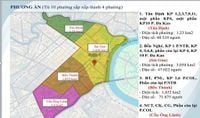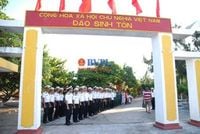On April 16, 2025, the Department of Home Affairs of Khanh Hoa province announced a significant plan to reorganize its administrative units at the commune level. This initiative aims to streamline the governance structure by reducing the number of administrative units from 132 to just 40, which includes 29 communes, 10 wards, and 1 special zone. This represents a remarkable decrease of approximately 70%, as the province will eliminate 92 administrative units, consisting of 66 communes, 20 wards, and 6 towns.
Following the reorganization, Nha Trang City will see a reduction of 19 communes and wards, leaving only 3 administrative units: Nha Trang ward, which will comprise 12 wards, North Nha Trang ward, which will include Ngoc Hiep ward along with four communes, and South Nha Trang ward, which will consist of Phuoc Long ward and four other communes. This restructuring is seen as an essential step to enhance administrative efficiency and improve local governance.
Cam Ranh City is also set to undergo significant changes, with a reduction of 10 communes and wards, resulting in 5 remaining units: Cam Ranh ward (comprising 3 wards), Cam Ranh 1 ward (including 2 wards and Cam Thanh Nam commune), Cam Ranh 2 ward (comprising 3 wards), Cam Ranh 3 ward (which includes Ba Ngoi ward and Cam Phuoc Dong commune), and Cam Ranh 4 commune (comprising 4 communes). This reorganization aims to consolidate resources and improve service delivery to residents.
In Ninh Hoa town, the administrative units will be reduced from 18 to 8, encompassing Ninh Hoa ward (comprising 2 wards and 2 communes), Ninh Hoa 1 commune (which will include 3 communes), Ninh Hoa 2 ward (comprising 3 wards and Ninh Phuoc commune), Ninh Hoa 3 ward (which will have 2 wards and Ninh Phu commune), Ninh Hoa 4 commune (comprising 3 communes), Ninh Hoa 5 commune (which will include 4 communes), Ninh Hoa 6 commune (comprising 2 communes), and Ninh Hoa 7 commune (with 3 communes).
Van Ninh district will also see a reduction of 8 administrative units, leaving 5 communes: Van Ninh commune (which will include Van Gia town and 2 communes), Van Ninh 1 commune (comprising 3 communes), Van Ninh 2 commune (which will consist of 3 communes), Van Ninh 3 commune (with 2 communes), and Van Ninh 4 commune (comprising 2 communes). This move is expected to simplify governance and enhance administrative efficiency.
Dien Khanh district will reduce its number of administrative units from 11 to 6, which will include Dien Khanh commune (comprising Dien Khanh town and 2 communes), Dien Khanh 1 commune (with 3 communes), Dien Khanh 2 commune (comprising 3 communes), Dien Khanh 3 commune (with 3 communes), Dien Khanh 4 commune (including 2 communes), and Dien Khanh 5 commune (with 3 communes). This restructuring is part of a broader effort to improve local governance.
Truong Sa island district will also experience a reduction, decreasing by 2 administrative units to form 1 special zone, which will include Truong Sa town and 2 communes. This change aims to better manage the island district and its unique challenges.
Cam Lam district will see a reduction of 10 administrative units, resulting in 4 communes: Cam Lam commune (comprising Cam Duc town, 3 communes, and part of 7 communes), Cam Lam 1 commune (including Suoi Cat commune and part of 3 communes), Cam Lam 2 commune (which will comprise Son Tan commune and part of 5 communes), and Cam Lam 3 commune (comprising Cam Phuoc Tay commune and part of 2 communes).
Khanh Vinh district will reduce its administrative units from 9 to 5 communes, including Khanh Vinh commune (comprising Khanh Vinh town and 2 communes), Khanh Vinh 1 commune (with 4 communes), Khanh Vinh 2 commune (comprising 3 communes), Khanh Vinh 3 commune (with 2 communes), and Khanh Vinh 4 commune (including 2 communes). This is part of a strategy to streamline governance.
Khanh Son district will reduce its administrative units from 5 to 3 communes: Khanh Son commune (comprising To Hap town and 2 communes), Khanh Son 1 commune (with 2 communes), and Khanh Son 2 commune (comprising 3 communes). This change is expected to enhance administrative efficiency in the region.
According to the Khanh Hoa Department of Home Affairs, district-level People's Committees must develop project files to arrange commune-level administrative units and submit them to the provincial People's Committee by April 20, 2025. This includes gathering public opinions on the project. The Provincial People's Committee Office will monitor and compile project files to advise the Provincial People's Committee to report to the Ministry of Home Affairs by May 1, 2025.
On April 17, 2025, Pham Thi Thuy Hang, Vice Chairwoman of the District 3 People's Committee in Ho Chi Minh City, announced a proposed plan to reorganize administrative units within the district. Currently, District 3 has 10 wards, but the proposed plan aims to reduce this number to just 3 wards, with the new names suggested as Nhieu Loc, Xuan Hoa, and Ban Co.
The proposed Nhieu Loc ward will be formed by merging the entire area and population of wards 9, 11, 12, and 14, resulting in an area of 1.71 km² and a population of approximately 88,090 people. Xuan Hoa ward will be established by merging the entire area and population of Vo Thi Sau ward and part of neighborhood 3 from ward 4, resulting in an area of 2.217 km² and a population of about 48,446 people. Finally, Ban Co ward will be formed by merging the entire area and population of wards 1, 2, 3, 5, and the remaining part of ward 4 (excluding neighborhood 3), with an area of 0.99 km² and a population of around 67,634 people.
As of April 17, 2025, the rate of agreement from voters regarding this proposal has reached over 92%, indicating strong community support for the changes. In addition to the reorganization plan, Thuy Hang informed voters about preparations to address policies for non-professional staff following the restructuring. Statistics show that after the reorganization, District 3 will have 154 non-professional staff, 20 of whom are nearing retirement age. The majority of the remaining staff (134 people) expressed a desire to continue working within the neighborhood system or seek suitable employment opportunities to stabilize their lives.
In Cam Ranh City, the proposed names for new wards and communes differ from the province's plan, which intends to name new administrative units after current districts, towns, or cities. The city's plan includes merging wards according to geographical areas to create 5 new wards and communes with distinct names.
The proposed names for Cam Ranh's new administrative units include Cam Ranh ward, which will be formed by merging Cam Phu, Cam Loc, and Cam Phuoc Nam wards. Additionally, Bac Cam Ranh ward will be formed by merging Cam Nghia and Cam Phuoc Bac wards along with Cam Thanh Nam commune. Nam Cam Ranh commune will include 4 island and mainland communes bordering Cam Ranh Bay, while Cam Linh ward will merge Cam Linh, Cam Thuan, and Cam Loi wards. Finally, Ba Ngoi ward will be formed by merging Ba Ngoi ward and Cam Phuoc Dong commune.
In Van Ninh district, the proposed names for the new communes also differ from the provincial plan. The district intends to merge existing units into 5 new communes based on geographical areas, with names reflecting their local heritage and history.
These ongoing administrative reorganizations in Khanh Hoa and Ho Chi Minh City reflect a broader trend across Vietnam to enhance governance efficiency, improve service delivery, and better align administrative structures with the needs of local communities. As these changes unfold, they will likely have a significant impact on the way local governance operates and how residents interact with their administrative units.







